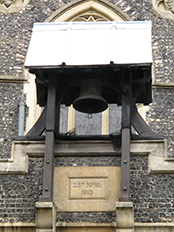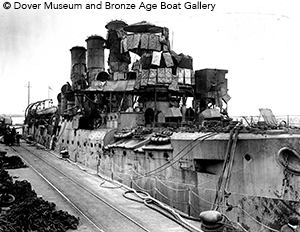Dover Town Hall:

The Town Hall has over 800 years of history with several distinct phases. Founded in 1203 primarily as a hospice (hostel) for pilgrims, it was closed by Henry VIII in the 16th century and became a Crown victualling depot for the Royal Navy but was sold to the Town Council in 1834 who converted the premises into a town hall and court.

Victualling Office circa 1735
d11746
Looking at the building from the front, the tower to the right and the hall at the top of the steps are among the remnants of the ancient Maison Dieu. Note the tops of the arches visible on the tower, just above the pavement, which show how the street level has risen.

Connaught Hall grand opening banquet 1883
To the left of the building the remains of a 13th century church gave way in 1867 to a four storey prison. This was demolished to make way for the present building faced with knapped flints, designed by William Burges in gothic revival style. It was opened in 1883 by the Duke and Duchess of Connaught who also opened Connaught Park on the slopes below the castle.
Originally the site was a hospice (hostel) for pilgrims (en route to Thomas Becket’s shrine at Canterbury) and needy travellers probably founded in 1203 by Hubert de Burgh, Earl of Kent and Constable of Dover Castle. Their wants were catered for by a Master and Augustinian Brethren until its suppression by Henry VIII in the 16th century. Later it became a Victualling Office (store depot) for the navy. It was purchased by the Town Council in 1834 for use as a town hall and court. The Victorian restoration of the late 13th century hall, designed by architects Ambrose Poynter and William Burges, is lit by six great windows, which are filled with painted glass designed by Edward J. Pointer, later Director of the National Gallery and President of the Royal Academy. These windows, installed by 1873, depict six scenes from Dover’s history from the 1216 siege of Dover Castle by the French to the 1660 landing of the restored King Charles II. . There are portraits of Queen Elizabeth the Queen Mother, Sir Winston Churchill, other Lords Warden of the Cinque Ports, Mayors as well as regimental colours (flags) and displays of arms. Burges’s 1883 Connaught Hall retains medieval arches, remnants of the 13th century church., The Mayor’s Parlour still contains some of Burges’s original decoration and furniture. The council chamber, built in 1868, is impressive with a rare sunburner gas light and a Cinque Ports banner dating from 1632. The chapel, consecrated in 1227, was converted into the town’s Petty Sessional Court in 1836 and used until 1987.
Hanging on the façade under a wooden canopy is the Zeebrugge Bell which is rung on 23rd April at noon. A plaque beneath it tells its history.

Zeebrugge Bell

HMS Vindictive after the Zeebrugge Raid
d17150

Victualling Office circa 1735
d11746

Connaught Hall grand opening banquet 1883

Zeebrugge Bell

HMS Vindictive after the Zeebrugge Raid
d17150